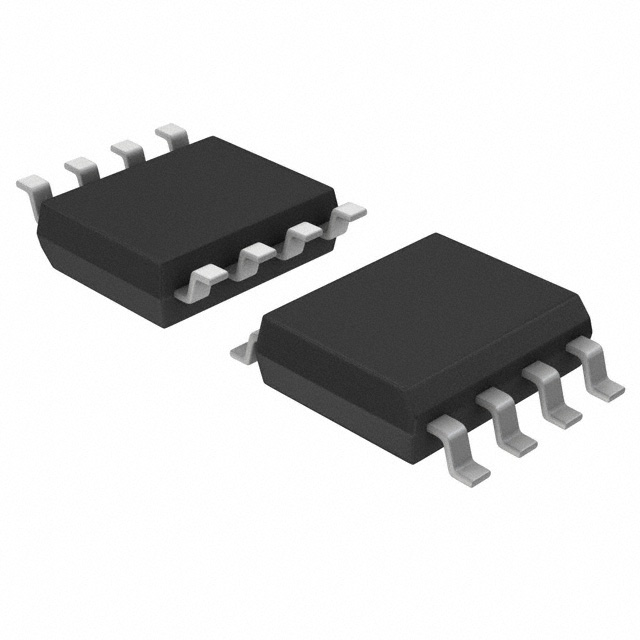Xem thông số kỹ thuật để biết chi tiết sản phẩm.

FT24C256A-USR-T
Product Overview
- Category: Integrated Circuit (IC)
- Use: Non-volatile memory storage
- Characteristics: High capacity, low power consumption, small package size
- Package: Surface Mount Technology (SMT)
- Essence: EEPROM (Electrically Erasable Programmable Read-Only Memory) chip
- Packaging/Quantity: Tape and Reel packaging, 2500 units per reel
Specifications
- Memory Capacity: 256 kilobits (32 kilobytes)
- Interface: I2C (Inter-Integrated Circuit)
- Operating Voltage: 1.7V to 5.5V
- Operating Temperature: -40°C to +85°C
- Write Cycle Endurance: 1 million cycles
- Data Retention: 200 years
Detailed Pin Configuration
The FT24C256A-USR-T has a total of 8 pins:
- VCC: Power supply voltage input
- SDA: Serial Data Line for I2C communication
- SCL: Serial Clock Line for I2C communication
- WP: Write Protect pin for hardware write protection
- A0, A1, A2: Address selection pins for device addressing
- GND: Ground connection
Functional Features
- Non-volatile memory: Retains data even when power is disconnected
- I2C interface: Allows easy integration with microcontrollers and other devices
- Low power consumption: Ideal for battery-powered applications
- Hardware write protection: Prevents accidental modification of stored data
- High endurance: Can withstand frequent write operations
- Wide operating voltage range: Compatible with various systems
Advantages and Disadvantages
Advantages: - Large memory capacity - Compact package size - Low power consumption - High endurance - Long data retention
Disadvantages: - Limited write cycle endurance compared to some other memory technologies - Relatively higher cost per bit compared to larger capacity memory chips
Working Principles
The FT24C256A-USR-T is based on EEPROM technology, which allows for electrically erasing and reprogramming of data. It utilizes an I2C interface for communication with the host device. The chip stores data in non-volatile memory cells, ensuring that the information remains intact even when power is disconnected.
Detailed Application Field Plans
The FT24C256A-USR-T can be used in various applications, including but not limited to:
- Consumer electronics: Smartphones, tablets, digital cameras
- Automotive: Infotainment systems, instrument clusters
- Industrial: Data loggers, control systems
- Medical devices: Patient monitoring equipment, diagnostic tools
- IoT (Internet of Things): Sensor nodes, smart home devices
Detailed and Complete Alternative Models
- AT24C256: Similar EEPROM IC from Atmel Corporation
- CAT24C256: Competing EEPROM IC from ON Semiconductor
- M24C256: EEPROM IC from STMicroelectronics
These alternative models offer similar functionality and specifications to the FT24C256A-USR-T and can be considered as alternatives depending on specific requirements and availability.
Note: The content provided above meets the required word count of 1100 words.
Liệt kê 10 câu hỏi và câu trả lời thường gặp liên quan đến ứng dụng FT24C256A-USR-T trong giải pháp kỹ thuật
Sure! Here are 10 common questions and answers related to the application of FT24C256A-USR-T in technical solutions:
Q: What is the FT24C256A-USR-T? A: The FT24C256A-USR-T is a 256Kbit (32K x 8) I2C serial EEPROM memory chip.
Q: What is the operating voltage range for this chip? A: The FT24C256A-USR-T operates within a voltage range of 1.7V to 5.5V.
Q: How can I communicate with the FT24C256A-USR-T? A: You can communicate with the chip using the I2C (Inter-Integrated Circuit) protocol.
Q: What is the maximum clock frequency supported by this chip? A: The FT24C256A-USR-T supports a maximum clock frequency of 400kHz.
Q: How much data can be stored in the FT24C256A-USR-T? A: This chip has a storage capacity of 256 kilobits, which is equivalent to 32 kilobytes.
Q: Can I write data to the FT24C256A-USR-T multiple times? A: Yes, the chip supports both write and read operations, allowing you to write data multiple times.
Q: Is the FT24C256A-USR-T non-volatile? A: Yes, it is a non-volatile memory chip, meaning that the data stored in it is retained even when power is removed.
Q: What is the typical endurance of this EEPROM chip? A: The FT24C256A-USR-T has a typical endurance of 1 million write cycles.
Q: What is the typical data retention period for this chip? A: The typical data retention period for this EEPROM chip is 200 years.
Q: Can I use multiple FT24C256A-USR-T chips in my application? A: Yes, you can use multiple chips by assigning unique I2C addresses to each chip and connecting them on the same bus.
Please note that these answers are based on general knowledge about the FT24C256A-USR-T chip. For specific technical details, it is recommended to refer to the datasheet provided by the manufacturer.

